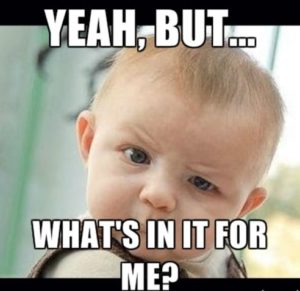Creating A Compelling Trade Show Product Demo
 I believe that a large number of trade show product demo’s don’t get the exhibitor the results they want. Why? Because they’re focused on the product, not the prospect.
I believe that a large number of trade show product demo’s don’t get the exhibitor the results they want. Why? Because they’re focused on the product, not the prospect.
What’s the solution? Making your audience care. And typically, audiences don’t care about features and benefits. They care about what your product can do for them. Not everyone who buys the product. Them alone.
That’s the secret. So how do you make your prospects care? You can’t, unless you know them.
What To Do Before The Demo:
A good trade show product demo can’t start with a demonstration. It needs to start with an investigation.
I’m not suggesting breaking out the bright lights and rubber hoses. But you need to begin with simple, straightforward and open-ended questions about what the prospect’s needs are:
1. How are you making widgets now?
2. What equipment are you currently using?
3. What would make the process better (faster production, stronger widgets, lighter weight, less expensive, etc.)?
4. What do these existing deficiencies or inefficiencies cost you?
5. What’s your biggest frustration about your current process?
As you’re engaged in your discovery process, what happens when your prospect has questions of his or her own? Of course, you do your best to answer them simply and clearly. But sometimes, you may find yourself without an easily articulated answer. In that case, ask a question in response to their question.
If they ask, “Is it possible to do X?” you might think the best way to respond is to say “Yes” and launch into your trade show product demo, showing them how.
But you may uncover an issue if you were to ask, “Is it important for you to be able to do X?” It may be that’s exactly the part of the process they don’t want to be possible.
By asking a question yourself, you’re not being evasive. You’re showing an interest in getting at their specific needs.
What To Do During The Demo:
Every good product demo has an interesting story to tell. It may be a story about a day in the life of your prospect that shows how your product can help in various ways.
However you craft the story, always make the prospect the hero. In every great story, the hero has to overcome some obstacle to reach a goal, from getting back home (The Wizard of Oz) to saving the damsel in distress (Sleeping Beauty).
In your trade show product demo, however, your product has to be pivotal in helping the hero succeed. Your story should clearly show how the prospect’s life would change once he or she had become a customer. This story has a clear beginning, middle and end.
People are naturally attracted to stories, and they can powerfully connect all kinds of technologies and products with a person’s actual life experience. Ideally, you’d like to have a story that can branch out to include every feature of your product.

Steve Jobs Product Announcement for Mac Air laptop at the MacWorld Conference in San Francisco Jan 2008
But to do this, you need to create a script—an actual step-by-step written script. It’s not imperative (or even desirable) that you stick slavishly to the script with every trade show product demo. But it helps to know where you’re going. Scripting also allows you to tell your story effectively and stay on track as you present.
Writing your script is also valuable in helping you create a “knockout moment,” which showcases the best aspect of your product. For example, you probably remember watching Steve Jobs opening a manila envelope to unveil the MacBook Air. It was an amazing way of memorably showing how small Apple’s product was.
Depending on how long your demo is, or which features you end up focusing on, your script may have several “knockout moments.” Don’t overload your prospect, but incorporate at least one into every demo.
Let the prospect take the lead in this dance. You are trying to convince him or her to purchase your product, so it makes sense to let them go where they want to go so they can feel what it feels like to own and use that product. If you’ve scripted things well, you can do this easily, picking up wherever they want to take things.
Finally, practice your demo until you’re blue in the face. You don’t want it to come out “canned.” But you also don’t want to be fumbling for words. Being completely comfortable with the material will allow you to relax and focus on the prospect, rather than struggling for what to say.
What To Do After The Demo:
We’ll assume you did a good job of asking the right questions to understand the prospect you were presenting to. You also did well with scripting and delivering your trade show product demo. You focused on a few features and benefits that were important to that particular prospect. You spoke clearly and slowly, in a conversational tone. And you included at least one memorable “knockout moment” that cemented your product’s abilities in your prospect’s mind.
Now what? Think of the demo not as an end in itself, but rather, a means to an end. In all likelihood, you haven’t covered everything your prospect wants to know. So leave time for questions and answers.
Answer the prospect’s questions, and ask your own “closing questions,” as well. It can even be as simple as “So, does the product do what you need it to do?” If the demo went well, the question have been answered and you’ve gotten good responses to your closing questions, there’s only one thing left to do:
Ask for the business.
This means different things to different people. What’s important is that you’re closing. You may be “closing” in the sense of writing an order. But things might work differently in your industry. You might simply be closing on the next step in the sales process.
In any case, don’t hesitate to ask for what you’ve decided is your “closer.” After experiencing your trade show product demo, they know what it’s like to own or use your product. So there’s no better time for the prospect to be in the mood to buy—or move a step closer to buying.
Maybe you’re a step closer to buying a new trade show booth, and you just need a little nudge to get you to write the order. Would a free 3D rendering of your new exhibit be enough to get you to consider American Image Displays? We’d be happy to show you what your own brand new tradeshow displays would look like. Just give us a call at (800) 676-3976 or email [email protected].
For more on how to liven up your trade show demos or how to simplify your presentations.
